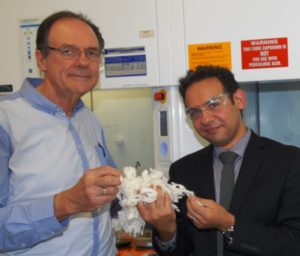
From the shearing shed to catwalk, world stockpiles of waste wool are suddenly in fashion with Flinders scientists who have found a way to give them high value.
Flinders University researchers have developed clean technology to dissolve waste wool and unwanted woollen products to produce a high-value protein called keratin and other byproducts with varied potential applications.
Well known on packaging of popular hair products, the scientists have worked out how to distil keratin from wool using a non-toxic, biodegradable chemical process to ‘dissolve’ the wool fibres with an eye on potential end uses in the cosmetic, pharmaceutical and even animal feed markets.
The South Australia Premier’s Professorial Research Fellow in Clean Technology at Flinders, Professor Colin Raston, says the discovery is an outstanding example of reducing waste in a safe way to make use of – and create value – from an existing resource.
“The future of clean technology is rapidly growing as the cost of producing expensive substances is offset against the benefits of low-cost, efficient, and environmentally sustainable recycling processes such as this,” Professor Raston says.
“After breakdown using a choline-chloride-urea solvent ‘melt’, the keratin nano-materials can be further refined and freeze dried to form a protein powder, to be used for a range of products ranging from wound healing in bandages to animal feedstock.
The ‘green chemistry’ process is simple, efficient, and environmentally friendly, says Dr Ramiz Boulos, who worked on the breakthrough technology with Professor Raston and fellow researchers Dr Katherine Moore, Daniel Mangos and Dr Ashley Slattery.
“Sheep wool is clearly an abundant biomaterial, with the wool weaving industry worldwide discarding tonnes of low grade non-spin wool fibres every year and much more landfill from wool garments from human waste,” Dr Boulos says.
“Our system makes use of a waste stream, deemed unsuitable for the clothing industry, to produce an additional revenue source.”
Dr Boulos, who previously demonstrated a similar process to deconstruct his own hair, says the benign eutectic melt used to break down wool and human hair creates the opportunity to extract the valuable keratin with another straight forward process, such as simple dialysis techniques and then concentrated using freeze drying.
“The final product would be highly useful for electro-spinning to form keratin bandages or for implantation into a hydrogel, both of which have demonstrated clear wound healing advantages.”
The research, funded by the Australian Research Council and Government of South Australia, was supported by Flinders Microscopy and the Australian Proteome Analysis Facility through the Federal Government’s National Collaborative Research Infrastructure Strategy.
The paper, Wool deconstruction using a benign eutectic melt, has been published by the Royal Society of Chemistry journal RSC Advances.

